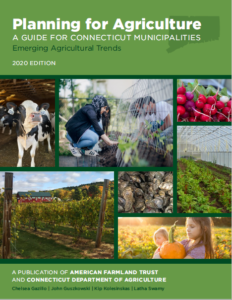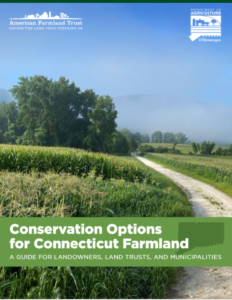Working Lands Alliance – a project of American Farmland Trust – is excited to announce the release of two newly revised educational guides: Planning for Agriculture and Conservation Options for Connecticut Farmland that have served as go-to resources for landowners, land trusts, municipalities, policymakers, and nonprofit organizations interested and invested in creating prosperous agricultural environments for farmers and farm businesses in the State. The updated versions of the guides were paid for by the CT Department of Agriculture through the Community Investment Act.
 The 2020 revisions to the Planning for Agriculture guide include emerging agricultural trends and ways that town governments can plan and provide a supportive community atmosphere where agriculture can thrive. The updated version of the guide covers topics including the benefits of farms; climate change mitigation, adaptation, planning, and zoning tools; right-to-farm ordinances; subdivision regulations; financing local farmland protection; promoting local farm viability; increasing land access opportunities for new, beginning, and Black, Indigenous, and People of Color; and addressing common farming issues and concerns.
The 2020 revisions to the Planning for Agriculture guide include emerging agricultural trends and ways that town governments can plan and provide a supportive community atmosphere where agriculture can thrive. The updated version of the guide covers topics including the benefits of farms; climate change mitigation, adaptation, planning, and zoning tools; right-to-farm ordinances; subdivision regulations; financing local farmland protection; promoting local farm viability; increasing land access opportunities for new, beginning, and Black, Indigenous, and People of Color; and addressing common farming issues and concerns.
 The 2020 revisions to the Conservation Options guide include information about farmland protection, open space protection, updated information on federal and state farmland protection programs and answers questions many landowners have about protecting their land with an agricultural conservation easement. The guide also includes information on tax considerations and estate planning, as well as extensive information on grant programs and other resources needed to make farmland preservation a reality. The newly revised version of the guide also includes information about the USDA-NRCS’s new Buy-Protect-Sell provision and the CT Department’s Buy-Protect-Farm provisions.
The 2020 revisions to the Conservation Options guide include information about farmland protection, open space protection, updated information on federal and state farmland protection programs and answers questions many landowners have about protecting their land with an agricultural conservation easement. The guide also includes information on tax considerations and estate planning, as well as extensive information on grant programs and other resources needed to make farmland preservation a reality. The newly revised version of the guide also includes information about the USDA-NRCS’s new Buy-Protect-Sell provision and the CT Department’s Buy-Protect-Farm provisions.
“Connecticut may be small in size, but our agriculture industry is vast — so influential, in fact, that it contributes an impressive $5.2 billion to the state’s economy each year. These guides provide the framework to ensure these great farm businesses remain viable for future generations and create opportunities for new and beginning farmers to operate and grow” said Connecticut’s Department of Agriculture, Commissioner Bryan Hurlburt.
“Connecticut’s communities and landowners are looking for ways to increase food security, address climate change, and successfully transition farms and businesses to a diverse next generation of agricultural producers. The updated Planning for Agriculture and Conservation Options Guides provide the tools and information to be successful” said Kip Kolesinskas, consulting Conservation Scientist and Co-Chair of the Working Lands Alliance.
“In light of the COVID-pandemic, the impending threat of climate change, and an increase in the number of individuals who are food insecure, supporting our farms and farm businesses in Connecticut has never been more important. With both the updated Planning for Agriculture and Conservation Options guides we can ensure that all of our communities – urban, suburban and rural – have the right tools to promote agriculture, support farmers and producers in the implementation of climate-smart agricultural practices, provide residents across CT with healthy, nutritious food, and to grow our state’s farm economy “ said Chelsea Gazillo, Director of the Working Lands Alliance for American Farmland Trust.
“Good community planning means making land-use decisions. Agriculture is a critical land use for our economy and food system. We need to do everything we can in Connecticut to ensure a healthy, vibrant, and sustainable agricultural sector and food system. These guides will help Connecticut’s farmers, landowners, and communities understand, prepare, preserve, and plan for the future of farming in our state. I am proud and happy to be a part of this project” said John P. Guszkowski, Project Manager, Planning & Landscape Architecture Group, CHA, member of American Institute of Certified Planners (AICP) and the Connecticut Chapter of the American Planning Association (CCAPA)
“I’m thrilled to see the launch of the 2020 updates of the Planning for Agriculture Guide for Connecticut Municipalities and Conservation Options for Connecticut Farmland – A Guide for Landowners, Land Trusts, & Municipalities. They are key resources in Connecticut since they both provide roadmaps and set of foundational tools for state and local government officials, policymakers, farmers, planners, and communities on how best to support a thriving, just, and inclusive agricultural sector. For example, in Connecticut, urban agriculture is emerging as an important contender in the state’s agricultural landscape. Urban farms and gardens in Bridgeport, Hartford, New Britain, and New Haven – to name a few – continue to nurture a grassroots movement of urban growers of all ages across their cities, and more notably, as a network across the state. Local agriculture can mitigate the effects of climate change and provide for environmental resilience. Viewing agriculture in the cross-cutting lens of sustainability can engage a wider variety of stakeholders in this overall effort, and Conservation Options provides an array of programs, policies, and other tools farmers, municipalities, and landowners can engage with to accomplish this goal,” said Latha Swamy, MSc, MEM Food Policy & Planetary Health Consultant.
Planning for Agriculture, originally published in 2008, was previously revised and updated in 2012 and 2016 and is currently in its fourth edition. For over a decade, this guide has been an effective educational tool for numerous agencies and organizations throughout the state, such as the Connecticut Department of Agriculture, USDA-NRCS, and Connecticut Farm Bureau Association. It has been used extensively to educate local elected officials, municipal staff, Planning and Zoning and Agricultural Commission members, and many others about the importance of local agriculture and the role municipalities can play in supporting the growth of farming in our state.
Conservation Options for Connecticut Farmland, originally published in 2003, was previously revised and updated in 2006, 2009, and 2015 and is currently in its fifth edition. For almost two decades, this guide has been an effective educational tool for numerous agencies and organizations throughout the state, such as the Connecticut Department of Agriculture, USDA-NRCS, Connecticut Farmland Trust, and numerous land trusts. It has been used extensively to educate landowners and land trusts about the many options available to successfully protect the farmland parcels that define our communities.
To obtain hard copies of Planning for Agriculture: A Guide for Connecticut Municipalities or Conservation Options For Connecticut Farmland: A Guide for Landowners, Land Trusts, and Municipalities please contact Chelsea Gazillo – Working Lands Alliance Director at cgazillo@farmland.org or contact the Connecticut office of American Farmland Trust at 860-969-4386. Electronic copies of the guide may also be downloaded on the Working Lands Alliance website: http://workinglandsalliance.org/resources/
The Working Lands Alliance, a project of American Farmland Trust, is a statewide coalition dedicated to preserving Connecticut’s productive farmland and advancing the economic viability of agriculture. To learn more about the Working Lands Alliance, visit: www.workinglandsalliance.org or call 860-969-4386
The American Farmland Trust is the nation’s leading conservation organization dedicated to protecting farmland, promoting sound farming practices, and keeping farmers on the land. For more information on the policies and programs of the American Farmland Trust, visit www.farmland.org, follow us on Facebook at www.facebook.com/FarmlandNE or Twitter www.twitter.com/farmland
# # # #




